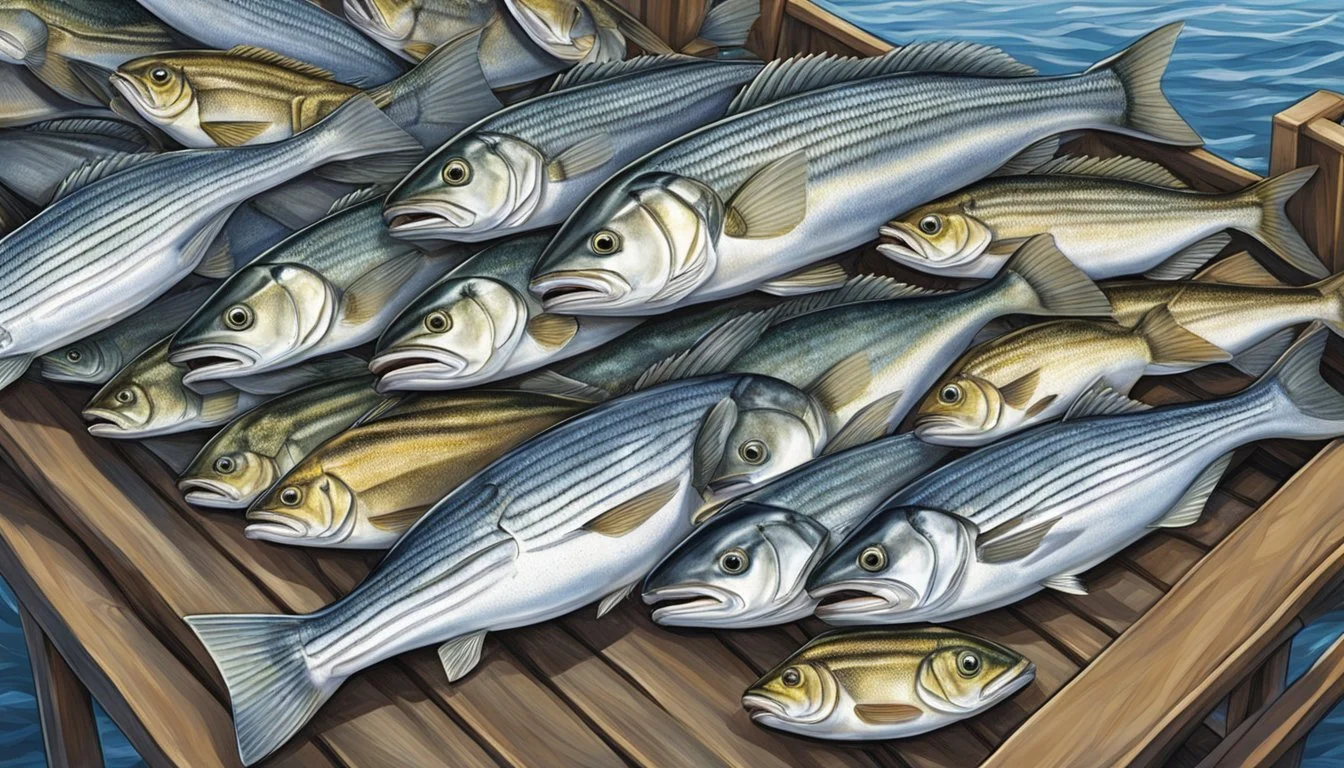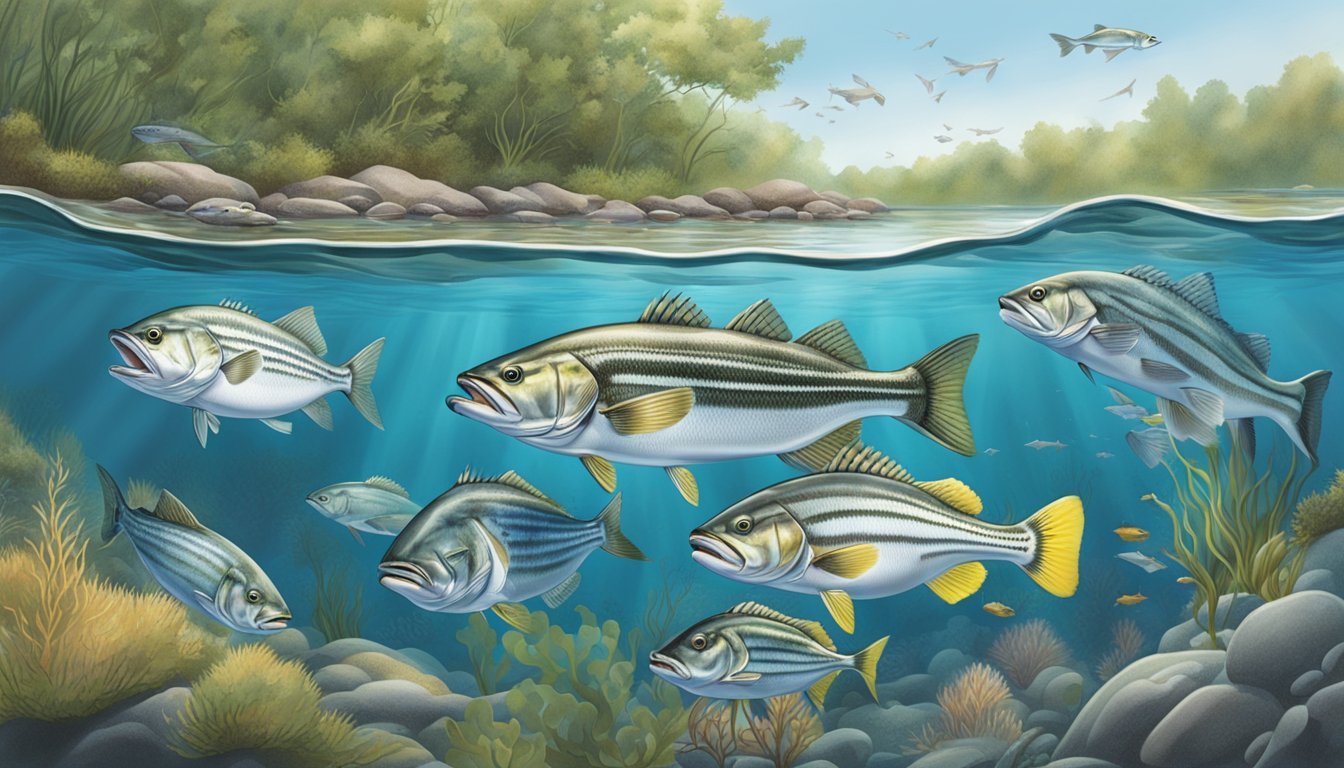Best Fish to Catch and Eat in New York
A Guide to Delicious Local Catches
New York's waterways offer a diverse array of fish (What wine goes well with fish?) species, making it a prime location for anglers looking to catch their next meal. From the vast expanse of the Atlantic Ocean to the Hudson River and countless lakes and streams, the state is home to both freshwater and saltwater fish that are lauded for their taste and quality. Among the prized catches, one can find striped bass, known for its firm texture and versatility in the kitchen, and flounder, sought after for its delicate, mild flavor.
Local regulations ensure sustainable fishing practices, so anglers can take pride in both the sport and the dining experience that follows. Seasonal migrations also provide unique opportunities to catch fish at their peak. To maximize the experience, it’s important to note that certain times of the year are more optimal for targeting specific species. For example, the spring and fall runs of striped bass in the Hudson River are not just exciting for fishermen, but they also yield some of the tastiest catch-and-eat opportunities.
When it comes to freshwater fishing, the lakes and rivers of New York are abundant with species like largemouth bass and perch. These fish are often praised for their flavor and can be prepared in a variety of ways to suit any palate. Whether it’s a simple pan-fried dish or a gourmet preparation, the fish caught in New York can offer an exceptional eating experience. As a center of culinary innovation, New York City also provides a multitude of ways to enjoy these local catches, with restaurants often sourcing straight from regional waters.
Understanding New York's Diverse Aquatic Habitats
New York State boasts a rich array of aquatic environments that cater to a variety of fish species. From the fresh waters of the Finger Lakes to the salty Atlantic waters off Long Island, these habitats are home to both resident and migratory species that vary by season.
Freshwater Regions of New York State
The freshwater regions of New York, including Central New York and Western New York, are known for their abundance of lakes, rivers, and streams. The Finger Lakes region is especially renowned for its pristine bodies of water which provide ideal conditions for species such as trout and landlocked atlantic salmon. The Hudson River flows through the state from north to south, supporting a diverse fish community thatlake changes as one moves downstream.
Saltwater Environments and the Atlantic Ocean
In the south of the state, including New York City and especially Long Island, saltwater environments dominate. These coastal waters are part of the vast Atlantic Ocean and support a wide range of marine life. Saltwater anglers enjoy the pursuit of species such as striped bass and bluefish, both of which are highly prized for their culinary qualities.
Seasonal Fish Movements
Fish movements in New York's waters are highly seasonal, with many species migrating to spawn or following food sources. During summer, for instance, many species like the atlantic salmon move into freshwater systems to spawn. Conversely, some species migrate to the ocean to spawn and only return to freshwater to feed. The dynamism of these migratory patterns plays a crucial role in the diversity of New York's aquatic habitats.
Popular Freshwater Species in New York
New York State offers a diverse range of freshwater fish, attracting anglers with species like largemouth and smallmouth bass, panfish, walleye, and coldwater habitats hosting prized trout and salmon.
Largemouth and Smallmouth Bass Fishing
In New York's freshwater lakes and rivers, both largemouth and smallmouth bass are highly sought-after game fish. Largemouth bass thrive in warmer, vegetated waters, while their relatives, the smallmouth bass, prefer cooler, rocky habitats. Anglers often target Lake Ontario for its excellent bass fishing opportunities.
The Role of Panfish in New York's Ecosystem
Panfish, including species like bluegill, perch, and pumpkinseed, play a vital role in New York's freshwater ecosystems. They serve not only as a fun catch for novice anglers but also as a key food source for larger predatory fish. These species are widespread and can be found in most of the state's freshwater bodies.
Pursuing the Prized Walleye
The walleye is a favorite among New York anglers, celebrated for its tasty meat and challenging catch. It is primarily targeted in deeper waters using live bait or jigs during the evening or at night. Lake Ontario is known to produce sizable walleye, contributing to New York State's reputation for excellent freshwater fishing.
Trout and Salmon: New York's Coldwater Treasures
New York State is home to an array of coldwater fish, with species like Atlantic salmon, brown trout, and lake trout. These fish thrive in the cooler waters of New York's lakes and streams. The state's management efforts ensure the sustainability of these populations, providing ongoing opportunities for anglers to enjoy the thrill of catching these prestigious species.
Saltwater Fishing: Coastal and Oceanic Game Fish
In the waters surrounding New York City, anglers find a diverse array of saltwater game fish, each offering a unique fishing experience and culinary delight. From the powerful striped bass to the delicate meat of flounder and bluefish, there's a fish for every season and seafood connoisseur.
Striped Bass: The Coastal Predator
Striped bass (Morone saxatilis), also known as rockfish, are iconic to New York's coastal regions. Anglers cherish this species for its fighting spirit and firm, white flesh which is highly valued as seafood. They are typically found in New York waters from April to November.
Habitat: Coastal waters, estuaries, and bays
Regulations: Strict regulations exist to protect this species, including size and bag limits that vary by season
Fluke and Flounder: Bottom-Dwelling Delights
Fluke, or summer flounder (Paralichthys dentatus), and their cousins the winter flounder, provide a stealthy challenge for anglers. Their camouflaged appearance makes them an exciting catch as they blend with the sea floor.
Habitat: Sandy bottoms near coastal areas
Taste Profile: Mild, sweet flavor with a fine, flaky texture
Season: Prime season is from May through September for summer flounder
Hunting for Bluefish and Black Sea Bass
Bluefish (Pomatomus saltatrix) are known for their aggressive behavior and strong flavor, making them a thrilling catch and a robust meal, while the black sea bass (Centropristis striata), with its delicate taste, is a favorite among those who prefer lighter, white-fleshed fish.
Bluefish:
Habitat: Inshore waters, often chasing schools of baitfish
Flavor: Rich, full taste best enjoyed fresh
Black Sea Bass:
Habitat: Structure-rich bottoms, such as wrecks and reefs
Flavor: Mild and slightly sweet, with a tender, yet firm texture
Best Practices for Catching Fish in New York
In the diverse waters of New York, anglers can increase their success by adopting effective fishing techniques, choosing the right bait, and understanding fish behavior in local habitats.
Effective Techniques and Lures
To maximize the catch in New York, anglers should focus on matching their techniques with the preferred habitat and feeding habits of local fish. For instance:
Striped Bass: Heavier jigs or spoons work well, especially near structures where these fish tend to feed.
Lake Trout: Downriggers can be quite effective when trying to reach the deeper waters where these fish reside. Spoons are a top choice for lures.
The Importance of Bait Selection
Selecting the appropriate bait is essential, as different species are attracted to different types of bait. Consider these specifics:
Freshwater Fishing: Nightcrawlers (worms) remain a staple for a wide array of species.
Saltwater Fishing: Squid, crab (What wine goes well with crab?), and shrimp are excellent bait for enticing fish like fluke and bluefish near the bottom or around sand areas.
How to Read Water and Understand Fish Behavior
Successful anglers in New York recognize the importance of reading water conditions and understanding fish behavior in their local environment. Key points:
Look for Aquatic Vegetation: Many fish use vegetation for cover and feeding.
Identify Power Spots: Areas with current breaks, such as boulders or downed trees, can concentrate fish.
Evaluate the Bottom Composition: Sandy bottoms might attract fluke, while rocky bottoms are preferred by species such as smallmouth bass.
Eating Fish Safely: Health Recommendations and Concerns
Eating fish in New York offers nutritional benefits, but it's important to be informed about potential contaminants that could pose health risks. The New York State Department of Health provides specific guidelines to ensure that fish consumption remains both beneficial and safe.
The Risks of Industrial and Environmental Contaminants
Fish in New York's waterways can accumulate harmful substances from pollution and industrial waste. Mercury and industrial chemicals such as PCBs are common contaminants. These substances can adversely affect the health and development of young children and fetuses when pregnant women consume contaminated fish.
Guidelines from New York's Department of Health
The New York State Department of Health has established consumption advisories to protect public health. They recommend:
Avoiding or limiting consumption of certain species from specific water bodies.
Eating smaller fish that may have less accumulation of contaminants.
Providing special advice for sensitive groups such as pregnant women and young children to ensure their safety and development is not compromised by exposure to contaminants.
Choosing Species with Lower Contamination Levels
Not all fish carry the same risk of contamination. Species like brown bullhead and rock bass may have higher levels of contaminants. In contrast, choosing to eat smaller fish or species known to have lower contamination levels can be a safer option for consuming fresh, food from local waters. It is advised to stay informed about which species are considered safer and to follow the latest guidelines from health authorities.
Regional Fishing Destinations and Their Iconic Species
New York State offers a diverse array of fishing destinations, from the vast waters of the Great Lakes to the rich ecosystems of the Hudson River. Each region boasts its iconic fish species, attracting anglers seeking prized catches for both sport and culinary delights.
Great Lakes and the Legendary Lake Trout
The Great Lakes, particularly Lake Ontario and Lake Erie, are renowned for their lake trout populations. Anglers can expect to catch lake trout which are not only iconic in the region but also provide a flavorful dining experience when brought to the table. Lake trout are best targeted in the deeper, cooler waters where they thrive.
Lake Ontario: Known for trout and salmon, with productive fishing from spring to fall.
Lake Erie: Provides excellent opportunities for walleye, in addition to lake trout.
Hudson River and Its Rich Biodiversity
The Hudson River supports a diverse ecosystem where anglers find a variety of species. Notably, the river is home to striped bass, a popular game fish that is also highly valued for its firm, white flesh and mild flavor. Spring and fall runs see an influx of anglers eager to catch these migratory fish as they travel between the ocean and the river.
Striped Bass: An iconic catch during their migratory seasons.
Other Species: The river also hosts shad, sturgeon, and catfish, offering a broad fishing experience.
Fishing in The Finger Lakes Region: A Diverse Bounty
Within the Finger Lakes region, eleven lakes provide habitats for a plethora of fish species. Lake trout and bass are particularly abundant, and Seneca Lake and Cayuga Lake are standout destinations for trout fishing. Anglers commonly pursue smallmouth and largemouth bass for both sport and culinary enjoyment.
Smallmouth and Largemouth Bass: Targeted for their fighting spirit and suitability for various cooking methods.
Trout Varieties: Including rainbow, brown, and brook trout, for a rewarding catching and dining experience.
Urban Angling: Fishing Spots in and Around New York City
For those seeking fishing experiences within the urban environment, New York City presents several options. Sheepshead Bay offers a gateway to saltwater fishing, while Greenpoint on the East River provides a unique backdrop against the city skyline. Freshwater anglers find opportunities in Central Park Lake, particularly for catching bass.
Sheepshead Bay: Saltwater species such as fluke and striped bass.
Central Park Lake: A convenient urban oasis with catchable largemouth bass and panfish.
Conservation Efforts and Regulations
Effective fishery management is essential to ensure that the sport of fishing can be enjoyed by future generations. New York State has implemented measures focusing on preservation, enforcing size and catch limits, and investing in habitat restoration.
New York State's Role in Fishery Management
The New York State Department of Environmental Conservation (NYSDEC) is at the forefront of managing the state's fisheries. They balance ecological needs with the interests of the angling community, ensuring that New York's diverse regions, from Central New York to Western New York and the Hudson River, benefit from sustainable fish populations. Their management strategies involve regular stock assessments, setting regulations, and conservation initiatives aimed at a variety of sportfish species.
Understanding Size and Bag Limits
To maintain healthy fish populations, there are specific regulations anglers must follow. The NYSDEC stipulates:
Size Limits: Each fish species has a minimum size limit to ensure only mature fish are kept.
Bag Limits: Daily catch limits are enforced to prevent overfishing.
These regulations vary by region and species, and they are critically important for conservation success. Anglers contribute to sustainability efforts by adhering to these rules.
Habitat Restoration Initiatives
The New York Department of Environmental Conservation has invested in habitat restoration projects across the state. Essential efforts include:
Revitalizing waterways in Central and Western New York.
Enhancing the aquatic environments in the Hudson River corridor.
These projects aim to rebuild healthy ecosystems where fish can thrive, thereby supporting both the local environment and the sportfishing industry. Through careful management and restoration efforts, New York State ensures that its waters remain a haven for many desirable fish species.






